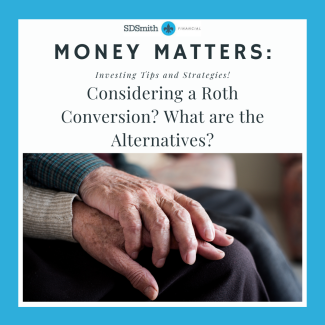
Considering a Roth Conversion? What are the Alternatives?
Are you considering a Roth Conversion in retirement, or maybe even starting it pre-retirement? The Roth Conversion is an excellent plan if done properly with the goal of doing two things, creating tax-free growth, and avoiding Required Minimum Distributions (RMDs). At the time of this article, RMDs are set to start at age 73, with a move to 75 in 2033. RMDs are the government’s way of making sure you pay your taxes on the funds you have put into tax deferred retirement accounts. Some people will never have to deal with RMDs, but a large portion of Americans are faced with RMDs during their retirement. If not handled properly, RMDs can have a substantial impact on the funds you have worked so hard to build. Let’s look at how RMDs can impact your assets, how a Roth Conversion works and avoids RMDs, and the primary alternative to the RMD problem.
If you are reading this, you are probably not in your RMD stage, and are still working, or newly retired. If you are in your RMD stage, skip ahead a couple of paragraphs to the alternative to the Roth Conversion. The RMD that we will be discussing is regarding a Traditional Retirement Account, such as but not limited to IRAs, 401Ks, 403Bs, and the TSP. These accounts typically build up a large portion of your retirement assets due to things like company match in an employer retirement plan, as well as your own contributions. So, how do RMDs work, and how are they calculated? The IRS publishes the Uniform Lifetime Table each year and adjusts for changes in life expectancy. This gives them the “Life Expectancy Factor” which is one of the variables used in determining your annual RMD. The other factor is your traditional accounts year end balance from the previous year. Let’s look at two examples:
Example 1: Age 75, Life expectancy factor is 24.6. 2023’s-year-end balance was $800,000. We divide that year end balance of $800,000 by the factor of 24.6 and get an RMD number of $32,520.33, or 4.06% of the portfolio balance.
Example 2: Age 87, Life expectancy factor is 14.4. 2023’s-year-end balance was $800,000. We divide that year-end balance of $800,000 by the factor of 14.4 and get an RMD number of $55,555.56, or 6.94% of the portfolio balance
When that money is distributed, it is treated as taxable income. This may not seem like a problem; however, the biggest issue is Social Security. An increase in taxable income can increase the amount of social security income that is subject to income taxes. If we choose to not take the RMD, then you are looking at a 25% penalty of the amount for not taking the distribution on time. The last piece of information on RMDs, if you have started RMDs, you cannot do a Roth Conversion.
If we are going to do a Roth Conversion to avoid the RMDs, we must do it before the RMDs start. The idea of the Roth Conversion is to move the assets from Traditional to Roth and pay the taxes on it now instead of when we are in our mid 70s till, we die. This allows us to grow this money tax-free and allows us to leave behind assets that are not going to tax our heirs. For a non-spouse, the traditional assets are going to be subject to the 10-year rule, meaning that the full account balance needs to be depleted within the next 10 years, and can be subject to required minimum distributions. This goes for the Traditional and the Roth accounts. The major difference is the heirs of the Traditional account will have to pay income taxes on the distributions as opposed to the Roth account, which can pull the dollars out tax free. The largest negative to this is the 5-year Roth Conversion rule. It is possible that even if you are over the age of 59.5, that the earnings from a Roth Conversion are subject to a penalty if withdrawn within the first 5 years. If you are interested in seeing if a Roth conversion is right for you, I would suggest speaking with a financial advisor that can assist you and make sure that you aren’t going to be hit with any major tax bills or illiquidity that you are not anticipating and ready for.
What is the alternative to the RMD issue? Just re-invest the RMDs after paying the taxes. If you need the money, the RMD isn’t going to be a big issue for you in retirement. However, if you find yourself in the fortunate position of not needing the government mandated income, you can invest it into a taxable account, and still receive estate planning benefits. This route does not come with any liquidity issues if done properly and can be owned in a Joint account with rights of survivorship for spouses. This allows a couple to keep the funds going forward, without having to go through the complexity of a Roth Conversion. And on that day that you eventually pass these funds to your heirs, they will receive a stepped-up cost basis. Let’s look at an example of how a stepped-up cost basis works.
Living: At age 75, an RMD is taken of $32,520, of which $25,000 is invested into a taxable account, and the remaining pays the taxes. This money is used to purchase 100 shares of a fund, valued at $250 a share. In 15 years, this fund is now worth $700 a share, giving us a total of $70,000, and $45,000 in long-term capital gains. If withdrawn, these would be subject to the capital gains tax.
Death: At age 90, the shareholder passes away. These shares are left to their children, who inherit the $70,000. The stepped-up cost basis, will raise the cost-per-share from $250 to $700, allowing them to sell while incurring a minimal capital gains tax hit.
Whatever method you choose for your retirement plan, it is important to know your options, and what works best for you and your specific situation. If you are looking for a financial advisor to consult with on your specific situation, use this link to set up a call.

